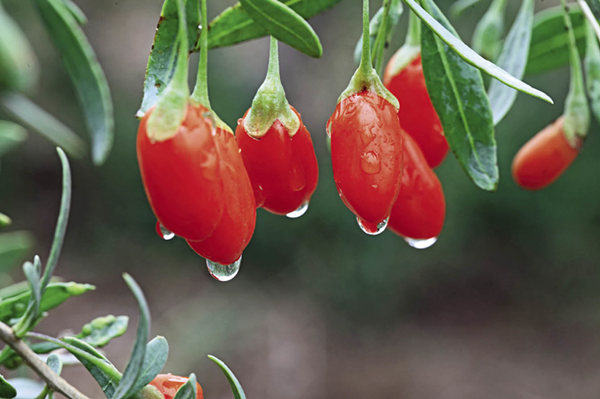Red Berries that Glint in the Desert
China Today by HUANG YUANJUN, December 21, 2016 Adjust font size:
The genes of goji berries produced in the Qaidam Basin are thus different from those growing in Ningxia, Xinjiang, and Gansu. This qualifies Haixi Prefecture to position its products as organic and high-end. At the same time, Haixi plans to build a plant base on the Qinghai-Tibet Plateau. “Natural conditions are our god-given advantage,” Vice Chairman of the Haixi Prefectural Committee of the Chinese People’s Political Consultative Conference Zhang Jiyuan said. “We have always set out to build a green brand based on quality products. This is the key to maintaining a cutting edge in market competition.”
Policies on supervising the quality of goji berries have been carried out by the prefectural administrations. Chemical pesticides and food additives are strictly forbidden. Production technologies and quality control are also standardized. Moreover, a national level quality and safety demonstration area for exported goji berries has been established in Golmud. Favorable financial policies have also been launched in such fields as plant disease and insect pest prevention, hygienic ways of drying goji berries, and green food authentication. Haixi’s dried goji berries have been certified as organic products by China’s Quality Certification Center, and by certification institutions in the EU, the U.S., and Japan. Exported to Europe, the U.S. and other Asian countries, Haixi’s organic produce makes up 90 percent of national total goji berry exports.

Goji berry, a small fruit that has promoted a big industry.
“Haixi has made outstanding achievements in the standardization, greenization, and organization of goji berry planting,” Zhang Jiyuan said. In addition to the strategies Zhang mentioned, the local government and producers also aim to develop more diversified and upscale products while building up production zones.
Ren Gang revealed that several new goji berry species had been cultivated in Haixi in recent years, which strengthens further their market appeal. In 2015, the estimated net worth of the Haixi goji berry brand was RMB 8 billion.
Red Glints on the Plateau
When traveling through the gobi in Haixi, red goji berries constantly catch the eye.
Haixi used to suffer from sandstorms. The harsh environment made it impossible for farmers to plant any crops other than highland barley, spring wheat, and oilseed rape. This forced them to subsist on meager incomes. However, locals did not complain and were not restricted by their unfavorable conditions. Having discovered the value of goji berries, they promoted them as an industry that benefits both themselves as farmers and the natural environment. The main thrust of their campaign was that goji berry trees help fix the sand and afforest desert. It was hence not only an emerging green agricultural industry, but also an environmental protection undertaking. Over the centuries, goji berries have hardily grown in desert. Their tenacity is echoed by the Haixi people, who strive to improve their hometown in an innovative yet steady and devoted way.
Legends about goji berries have been passed down for generations in Haixi. One tells of the Queen Mother of the West who, before she became immortal, made a living from digging up herbs in Wulonggou. Even after becoming a celestial goddess, she always felt concern for people’s well-being, and would transform herself into an old woman who gave herbs to mortals. It is said that she transformed her walking stick into a goji berry tree and her earrings into berries to treat patients. Another story tells of the Third Panchen Lama, who contracted smallpox at the age of 18. Fortunately he was cured by herbal medicine whose main ingredient was goji berries grown in the gobi. These tales reflect the long history of goji berries as a Chinese herbal medicine ingredient.
Today, local people are proud of their goji berry industry. Greater numbers of people now acknowledge Haixi and the Qaidam Basin as a main Chinese goji berry production base.